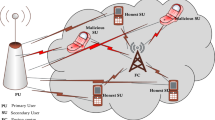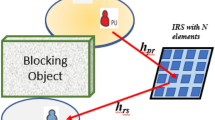Abstract
The average throughput of a cognitive radio (CR) system can be increased by performing spectrum handoff, however, it may cause high energy consumption. Therefore, it is necessary to build an energy efficient CR system while performing spectrum handoff. In this paper, a joint optimization problem of sensing time and transmission power is formulated to maximize energy efficiency (EE) of a CR system subject to the constraint on sufficient protection to the primary users while considering spectrum handoff. Swarm intelligence techniques, namely particle swarm optimization (PSO), human behavior-based PSO (HPSO), and whale optimization algorithm (WOA) are used in this study to evaluate joint optimal sensing time and transmission power. The performance comparison of the three techniques is presented in terms of fitness function (EE) and average computational time. The simulation results show that the three techniques achieve a unique joint optimal sensing time and transmission power at which EE attains the highest peak; WOA outperforms PSO and HPSO in terms of average computational time. The impact of joint optimization of sensing time and transmission power, the impact of variation of target detection probability as well as the variation of number of channels on EE are discussed. A quantitative comparison is also performed between the proposed work and the existing work.









Similar content being viewed by others
References
Facilitating opportunities for flexible, efficient, and reliable spectrum use employing cognitive radio technologies (ET docket no. 03-108). Technical report, Federal Communications Commission, Washington, DC, December 2003.
Shin, K. G., Kim, H., Min, A. W., & Kumar, A. (2010). Cognitive radios for dynamic spectrum access: From concept to reality. IEEE Wireless Communications,17(6), 64–74.
Wang, W. (2009). Spectrum sensing for cognitive radio. In 2009 third international symposium on intelligent information technology application workshops (pp. 410–412). IEEE.
Akyildiz, I. F., Lo, B. F., & Balakrishnan, R. (2011). Cooperative spectrum sensing in cognitive radio networks: A survey. Physical Communication,4(1), 40–62.
Lu, L., Zhou, X., Onunkwo, U., & Li, G. Y. (2012). Ten years of research in spectrum sensing and sharing in cognitive radio. EURASIP Journal on Wireless Communications and Networking. https://doi.org/10.1186/1687-1499-2012-28.
Liang, Y. C., Zeng, Y., Peh, E. C., & Hoang, A. T. (2008). Sensing-throughput tradeoff for cognitive radio networks. IEEE Transactions on Wireless Communications,7(4), 1326–1337.
Li, X., Zhao, Q., Guan, X., & Tong, L. (2010). Sensing and communication tradeoff for cognitive access of continues-time markov channels. In 2010 IEEE wireless communications and networking conference (WCNC) (pp. 1–6).
Song, F., Kan, C., Wu, Q., & Ding, G. (2015). Optimal cooperative spectrum sensing in interference-aware cognitive radio networks. Wireless Personal Communications,82(4), 2171–2184.
Feng, D., Jiang, C., Lim, G., Cimini, L. J., Feng, G., & Li, G. Y. (2013). A survey of energy-efficient wireless communications. IEEE Communications Surveys & Tutorials,15(1), 167–178.
Althunibat, S., Di Renzo, M., & Granelli, F. (2015). Towards energy-efficient cooperative spectrum sensing for cognitive radio networks: an overview. Telecommunication Systems,59(1), 77–91.
Zhang, J., Zheng, F. C., Gao, X. Q., & Zhu, H. B. (2014). Sensing-energy efficiency tradeoff for cognitive radio networks. IET Communications,8(18), 3414–3423.
Pei, Y., Liang, Y. C., Teh, K. C., & Li, K. H. (2011). Energy-efficient design of sequential channel sensing in cognitive radio networks: Optimal sensing strategy, power allocation, and sensing order. IEEE Journal on Selected Areas in Communications,29(8), 1648–1659.
Kang, X., Liang, Y. C., Nallanathan, A., Garg, H. K., & Zhang, R. (2009). Optimal power allocation for fading channels in cognitive radio networks: Ergodic capacity and outage capacity. IEEE Transactions on Wireless Communications,8(2), 940–950.
Kang, X., Zhang, R., Liang, Y. C., & Garg, H. K. (2011). Optimal power allocation strategies for fading cognitive radio channels with primary user outage constraint. IEEE Journal on Selected Areas in Communications,29(2), 374–383.
Wu, Y., & Tsang, D. H. (2011). Energy-efficient spectrum sensing and transmission for cognitive radio system. IEEE Communications Letters,15(5), 545–547.
Shi, Z., Teh, K. C., & Li, K. H. (2013). Energy-efficient joint design of sensing and transmission durations for protection of primary user in cognitive radio systems. IEEE Communications Letters,17(3), 565–568.
Wang, S., Wang, Y., Coon, J. P., & Doufexi, A. (2012). Energy-efficient spectrum sensing and access for cognitive radio networks. IEEE Transactions on Vehicular Technology,61(2), 906–912.
Qiu, T., Xu, W., Song, T., He, Z., & Tian, B. (2011). Energy-efficient transmission for hybrid spectrum sharing in cognitive radio networks. In 2011 IEEE 73rd vehicular technology conference (VTC Spring) (pp. 1–5).
Wang, Y., Xu, W., Yang, K., & Lin, J. (2012). Optimal energy-efficient power allocation for OFDM-based cognitive radio networks. IEEE Communications Letters,16(9), 1420–1423.
Ozcan, G., & Gursoy, M. C. (2014). Energy-efficient power adaptation for cognitive radio systems under imperfect channel sensing. In 2014 IEEE conference on computer communications workshops (INFOCOM WKSHPS) (pp. 706–711).
Li, L., Zhou, X., Xu, H., Li, G. Y., Wang, D., & Soong, A. (2010). Energy-efficient transmission in cognitive radio networks. In 2010 7th IEEE consumer communications and networking conference (CCNC) (pp. 1–5).
Awin, F., Abdel-Raheem, E., & Ahmadi, M. (2017). Joint optimal transmission power and sensing time for energy efficient spectrum sensing in cognitive radio system. IEEE Sensors Journal,17(2), 369–376.
Zhang, L., Xiao, M., Wu, G., Li, S., & Liang, Y. C. (2016). Energy-efficient cognitive transmission with imperfect spectrum sensing. IEEE Journal on Selected Areas in Communications,34(5), 1320–1335.
Bayhan, S., & Alagoz, F. (2013). Scheduling in centralized cognitive radio networks for energy efficiency. IEEE Transactions on Vehicular Technology,62(2), 582–595.
Kennedy, J., & Eberhart, R. (1995). Particle swarm optimization. In Proceedings of IEEE international conference on neural networks (ICNN) (pp. 1942–1948).
Shi, Y., & Eberhart, R. (1998). A modified particle swarm optimizer. In 1998 IEEE international conference on evolutionary computation proceedings (pp. 69–73).
Rao, S. S. (2009). Engineering optimization: Theory and practice. Hoboken: Wiley.
Liu, H., Xu, G., Ding, G. Y., & Sun, Y. B. (2014). Human behavior-based particle swarm optimization. The Scientific World Journal. https://doi.org/10.1155/2014/194706.
Mirjalili, S., & Lewis, A. (2016). The whale optimization algorithm. Advances in Engineering Software,95, 51–67.
Pandit, S., & Singh, G. (2017). Power allocation for optimal energy efficiency in MAC protocol of cognitive radio communication systems. In Spectrum sharing in cognitive radio networks (pp. 145–157). Cham: Springer.
Author information
Authors and Affiliations
Corresponding author
Additional information
Publisher's Note
Springer Nature remains neutral with regard to jurisdictional claims in published maps and institutional affiliations.
Rights and permissions
About this article
Cite this article
Ahmed, A., Baishnab, K.L. Joint Optimal Design of Sensing Time and Transmission Power for Maximizing Energy Efficiency in Cognitive Radio System. Wireless Pers Commun 110, 1839–1857 (2020). https://doi.org/10.1007/s11277-019-06814-z
Published:
Issue Date:
DOI: https://doi.org/10.1007/s11277-019-06814-z




